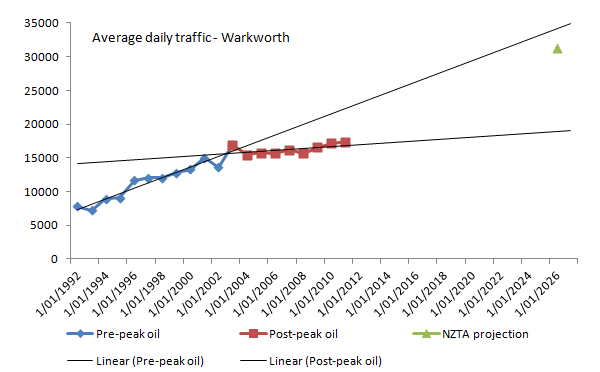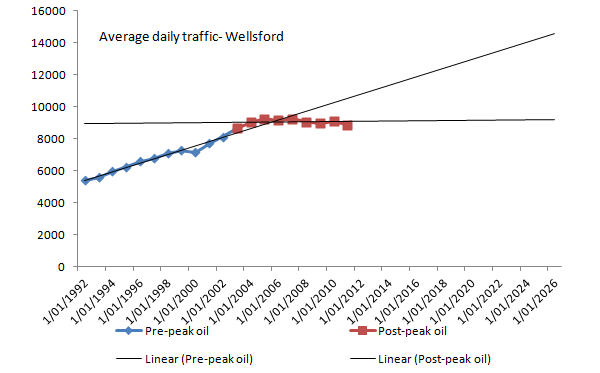Last night I went to see Jeff Rubin speak on his new book, The End Of Growth. As the former Chief Economist for CIBC World Markets he brings an intimate knowledge of financial markets and how they work to the peak oil/end of growth community populated by other venerable thinkers such as Richard Heinberg, Chris Martenson and John Michael Greer.
Rubin is a formidable speaker and for someone like myself who has been interested in these issues for a number of years it was exciting to see the auditorium close to sold out. This is a message that needs to be heard and I thank Jeff Rubin for taking his views on the road and speaking to people about them. He is also self-deprecating and humble, often referring to how he left CIBC World Markets due at least in part to the global financial crisis and the vast effects that had on the world.
Rubin spoke for roughly forty minutes followed by a forty minute question session. He covered many topics, mainly surrounding the global financial system, oil and gas, the Euro situation, the United States and of course Canada. I have collated his main points below under the relevant headings. Apologies to Jeff Rubin if any of the figures I recorded are incorrect.
The European Crisis
-
My question to Jeff Rubin during question time was this: Why is austerity the go to strategy in the Eurozone? If you were in charge what policies would you put in place to get Greece etc out of the current quagmire? Rubin predicts that Greece will default on loan repayments within the next 4-5 months and believes this is the only option left. Spain, Portugal and Italy will probably not be far behind (Portugal, Italy, Greece and Spain are referred to as the PIGS). For the last 200 years Greece has been in default 50% of the time so it is not anything particularly new for them. Germany wants to keep the PIGS in the monetary union because it lowers the Euro enough to make German exports attractive to overseas buyers. If the PIGS are forced to leave the monetary union German exporters will have to be bailed out. The big question is if the PIGS leave the monetary union will they also be forced to leave the Euro free trade zone?
-
Due to the interconnectedness of the global financial systems any defaults in Europe will be felt by absolutely everyone. It is likely that your bank has interests connected to a bank in somewhere like France that has interests in either Portugal, Italy, Greece or Spain.
The Global Financial System
-
The global financial system (GFC) remains relatively unchanged since the 2008 global financial crisis apart from losing a few major players such as the Lehman Brothers and Bear Sterns. Rubin believes we are at the beginning of another financial crisis right now and that in the aftermath financial systems will finally be reformed as they should have been after 2008.
-
Huge deficits and stimulus bailouts are no substitute for cheap oil because they don’t lead to long term growth.
General Predictions
-
Youth will stay at home longer until their mid 20s and people will work until they are much older. The time of leisurely retirements is over.
-
The global trade system will be greatly reduced as oil becomes more expensive. We will see the relocalisation of industry with agriculture and manufacturing producing much closer to markets.
-
The tax base will no longer grow and so governments will have to plan on little to no economic growth when making policy decisions.
-
Government will increasingly contract out services to private companies who can provide services at a cheaper rate in an effort to decrease government spending.
-
Real estate prices in cities and downtown areas will rise and outer suburbs may revert back to agriculture as people can no longer afford to commute large distances to and from work.
-
Education will shift to more practical skills that involve making things ourselves. The FIRE services (Finance, Insurance and Real Estate) will still exist but in a greatly reduced role.
-
Tourism will become much more localised. Air travel will revert back to what it was like in the 1960s and 1970s where ticket prices were four times higher than today.
Energy/Consumption
-
Energy consumption is easily reducible: Denmark reduced carbon emissions by 13% to 1990 levels as part of Kyoto commitments, in contrast Canada saw a 30% increase in carbon emissions over the same period (much of this due to the Alberta tar sands) and then left the Kyoto agreement.
-
Denmark's saw this carbon reduction with 80% of its electricity coming from coal with the other 20% coming from wind. This was due to high electricity prices meaning when it gets cold they put on more clothes rather than turning up the air conditioning. There is also a 180% surcharge on buying a car so many people either walk, cycle or use public transport.
-
Before the Japanese earthquakes last year Japan produced 30% of its electricity from nuclear power. Today that figure is 0% after shutting down all of its 34 nuclear power plants due to safety concerns.
-
Oil is four times as energy dense as natural gas making it much more viable as a transport fuel. The reason the price differential between oil and natural gas is not arbitraged is because natural gas is a very poor substitute for oil as a transit fuel.
-
As for the long term viability of shale gas it is worth watching the future of Chesapeake Energy, the largest investor in shale gas, which is currently in huge financial trouble.
Canada
-
Canada has seen a transformation into a petro-state over the last decade.
-
Canada has very low population density and so faces a unique set of problems.
-
The financial and power fault lines will increasingly be between the haves and have nots in terms of oil producing land. Ontario will be a big loser and the power and financial base will increasingly shift to where the oil is in Alberta and Newfoundland.
-
Mark Carney, the governor of the Bank of Canada, advises the public not to get mortgages but then keeps interests rates low that make mortgages attractive. This is akin to surrounding an overweight person with unhealthy food and telling them not to eat anything.
-
British Columbia would be foolish to accept the TransCanada pipeline to ship Albertan oil to China. It would be absorbing the environmental costs of the pipeline with little economic benefit to the area. Any spill would be devastating to marine life in the area and the surrounding economy.
Population
-
Japan is an opportunity to be studied as it has had a declining population for the last decade. It can be treated as a microcosm for where the rest of the world is heading.
-
Because economic growth is directly linked to lower birth rates, in an age of zero growth it is essential to focus on female education to reduce birthrates.
-
Hungry people have three choices: rebel, migrate or die. With lower energy use per capita migration is becoming increasingly difficult. The Arab Spring was in Rubin’s view Malthus come true. A huge population with very few economic options rebelled and overthrew a number of governments.
Some Policy Solutions
-
Job share policies such as seen in Germany are better than government stimulus because it keeps unemployment low by keeping people in work, albeit at reduced hours. The benefit of this is increased leisure time and a steady tax base.
-
There should have been massive investment in public transport after the GFC instead of bailing out car companies. Massive investment in public transport is essential.
-
Bank regulation is essential. Especially decoupling banks from investment firms which have been a major cause of problems since deregulation in the 1980s. Privatised benefits and socialised losses of banks is unacceptable and must be stopped.
-
Free money policies need to go.
Silver Linings for Climate Change
-
Scandinavian countries have some of the lowest consumption levels in the West but the highest levels of happiness.
-
As the world economy slows carbon emissions will also be reduced. This means that the emissions projections from the IPCC will probably never eventuate which will hopefully alleviate the worst of climate change.
-
Coal prices are already over $100 a tonne. Most climate change projections include massively increasing coal use although this is unlikely given where the global economy is heading. Where will all this coal come from and who can afford to pay those kinds of prices?
-
In 2009 U.S. carbon emissions fell not due to any government policy but due to zero growth.
-
When the USSR fell carbon emissions fell by 30% due to the massive contraction of the economy.






